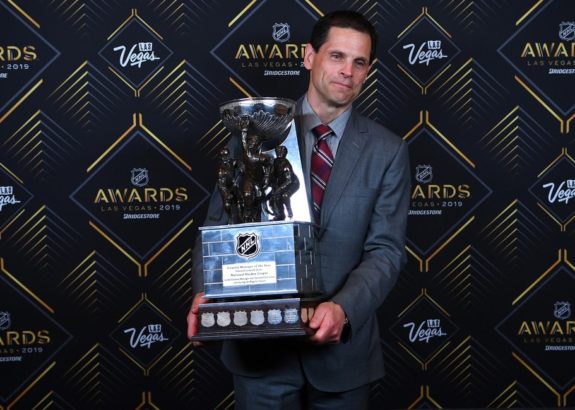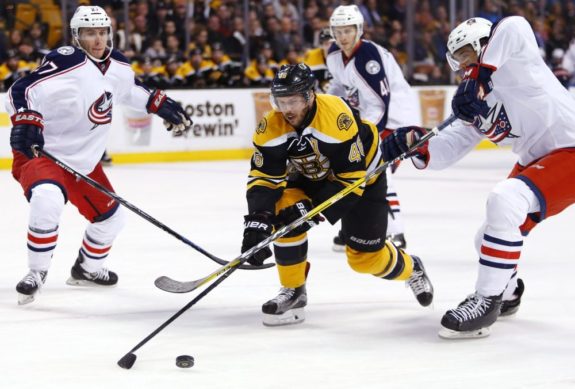A lot of fans were skeptical, to say the least when the Boston Bruins traded forward Danton Heinen to the Anaheim Ducks for left-wing Nick Ritchie. It wasn’t a surprise that Heinen was moved just before the trade deadline. It seemed that he was not producing up to the team’s expectations, a fact that was becoming more obvious as the season progressed.

The unexpected aspect of the Heinen deal was that the young winger went in a one-for-one trade for a somewhat unknown commodity in Ritchie. Many fans and members of the media were hoping or expecting that Heinen would instead be part of a larger deal that would bring in a higher-profile star like Chris Kreider or Kyle Palmieri.
Related: Top 10 Best Ice Hockey Leagues
Another bone of contention for many Bruins fans was that Nick Ritchie came to the team just a couple of months after his brother Brett Ritchie was placed on waivers by Boston and assigned to the team’s American Hockey League affiliate in Providence, R.I. The name Ritchie sent some fans into a panic with the memory of the failed Brett Ritchie experiment still fresh in their minds. However, it is not fair to judge Nick Ritchie based on the underwhelming performance of his brother.
The Big Picture
Those who were left scratching their heads after Bruins general manager Don Sweeney pulled the trigger on the trade that brought Nick Ritchie to Boston were not looking at the complete picture. To do that, it is necessary to consider both the Heinen deal and the one made a few days earlier that sent veteran forward David Backes, Boston’s first-round pick in the 2020 National Hockey League Entry Draft and defensive prospect Axel Anderson to Anaheim in exchange for Ondrej Kase. Look at these transactions as parts of one big deal that took place over the course of several days, and the move begins to make more sense.

Through these transactions, the Bruins unloaded 75 percent of Backes’ burdensome contract, which carried an average annual value of $6 million for this season and next. This was a major accomplishment, which looked next-to-impossible at times over the last nine months.
The fact that the Boston brass never required Backes to report to the team’s American Hockey League affiliate in Providence when he cleared waivers just before the All-Star break all but confirmed that Sweeney believed, or possibly knew for a fact, that there were teams interested in taking on part of the contract. Yes, the price to move Backes was high, costing the team a coveted first-round draft pick, but in reality, Sweeney got a bargain considering what he was gaining in exchange.
Related: Howie Morenz – Hockey Royalty
Following the trade, Sweeney found himself with not just two good wingers, but with substantially more wiggle room in the salary cap than he had before the trade deadline. With several key contracts set to expire after the 2019-20 season, including that of high-scoring defenseman Torey Krug, the importance of the extra cap space cannot be understated.
Adding Some Size
But that is just the financial side of why this trade was a stroke of efficient genius on Sweeney’s part. On the ice, it is looking like Nick Ritchie just might be the guy who can provide some of the qualities the Bruins were unable to get from Backes and Heinen.
Specifically, Ritchie has the size of a power forward. At 6-foot-3, and somewhere in the neighborhood of 230 pounds, Ritchie provides the big body and hard-hitting style that many believed were two of the key components missing in Boston’s 2019 playoff run. He is not a frequent fighter, but in just a few games in the Spoked-B, it has been easy to see that he does not shy away from the physical game that Heinen never really mastered.
Complementing Krejci
Another positive to Ritchie’s game is his straight forward, drive-to-the-net style. This is a trait shared by members of Bruins’ third and fourth lines that have been a major factor in the team’s success in recent years. On a line with a set-up artist like David Krejci and a smaller, quick puck handler like Kase, Ritchie’s skill set rounds out the trio nicely.

Of course, Heinen is an excellent puck handler and a solid defensive forward, and Backes could mix it up with the best of them when he was on his game. However, Ritchie can play both roles and, so far, looks like he may be more consistent than either of the two players who were traded to Anaheim were of late.
If the past few games are any indication, Ritchie looks like he could be a contributor to the score sheet, as well. Although he only has a couple of points since coming to Boston, he has had numerous good scoring chances. Unfortunately, the same could not be said of Heinen or Backes near the end of their tenures as Bruins.
Of course, Ritchie’s time in Bruins black and gold has just begun. There is still a lot to learn about his playing style and consistency, and it remains to be seen whether he can play a significant factor in the team’s postseason success. That being said, he is off to a very positive start. If he can continue playing as he has been, there is no reason to believe that he cannot fill the voids left by Heinen and Backes. And, he can do it at a decided discount. The upside simply cannot be overlooked.